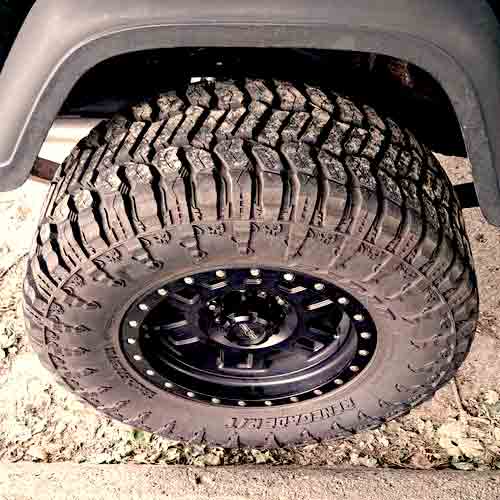Radar Renegade RT, as the name suggest, comes in “Rugged-Terrain” category of tires, which are also called hybrids. Such tires basically are more voided in their tread from outer margins, yet their central section remain compact like any other all-terrain tire.

In my expert opinion as a tire engineer, the Radar Renegade RT gives out very mixed results. It’s lateral traction is great thanks to it’s superb steering feedback offering capability, but it’s directional grip can be improved. And the tire does the opposite in wet, where you see good enough braking distances, but lacking cornering abilities with a tendency to slip. Though off-road the tire remains consistent in all departments, meeting your expectations.
Available Sizes
On the other side, the Radar Renegade RT comes in 20 to 24 inches with following specs:
- Load ratings available: XL, E and F only.
- Speed ratings available: T or Q.
- Weight range : 36 lbs to 91 lbs.
- Tread depth range: 13/32″ to 20/32″.
- LT sizes have 40k miles warranty, whereas non LT have 45k.
Side Note: The tire is the exact copy of Patriot R/T, you might wanna check that out first.
Tread Structure
Radar Renegade RT is a very aggressive looking tire.

Right off the bat, looking at this tire, you note how lugs are laterally arranged.
The blocks in the middle look like they are part of shoulders, only divided up by longitudinal tread voids.
With such a structure, the tire offers a lot of paddling, which is very effective on loose grounds such as fluffy snow, sandy, and muddy terrains.
Moreover, these lugs also have some cool features to them. They form sharp off-set edges, full depth sipes, and have reinforced foundations underneath them (for on-road stability).
Though the outer edges of the tire are the most aggressive. Its shoulder lugs are staggered, and they join up with the powerful biters on the sidewalls.
Winter Traction
As a tire tester, or should I say driver, I’m well-versed in the nuances of winter traction, which includes grip, acceleration, lateral traction, and stability across a wide range of snow and ice landscapes.
And let me tell you, you can’t expect much from aggressive off-road tires especially in the category of R/T and M/T.
So its not surprising to see the Radar Renegade RT lacking the famous 3-peak mountain snowflake rating symbol. The tire is not the ideal choice for hard-packed snow or icy conditions, as its almost non-existent siping diminishes its performance.
However, when faced with deeper snow up to 5 feet, these tires can still hold their own. That’s because all of its traction comes from scooping lugs, which throw back the fluffy snow particles to generate momentum.
Ride Quality
Renegade RT is great in this section, as it offers variable pitch technology where various ribs’ angles dampen the sound waves.
Most of the sound/noise (which is just air) comes from shoulders, and there the slanted lugs provide a very streamlined path for sound to get dampened down nicely.
These lugs basically form a laterally oriented structure with the central blocks as explained in its tread appearance section, so air particles move form one side to another without impacting on the tread walls, a lot.
Though the tire really lacks in the second part of the overall comfort, which is its effectiveness in mitigating road imperfections.
It’s stiffer compound is although pretty stable and offers a decent steering response, it’s not able to soak up the vibrations effectively, as seen on it’s direct competitors.
Puncture Resistance
Off-road, the sides of the tire are very vulnerable, so they need a stronger inner and outer construction.
And the Radar Renegade RT is as strong as it gets. It supplies you with a powerful 3 ply carcass, which then gets covered with 2 layers of steel belts.
These belts are then further reinforced with 2 nylon cap plies.
Moreover, the tire features killer sidewall lugs which besides providing traction, also adds to the overall protection of the 3 ply sides.
So, its safe to say, the tire is pretty solid. Take them anywhere without a worry.
Dry Performance
To gain a thorough understanding of the Radar Renegade RT tire, I examined some key components, such as directional grip and handling, along with it’s steering feedback. Let me talk about them one by one.
In dry conditions, an essential factor to consider is tread’s footprint, as higher contact with the ground increases friction and improves performance.
As a rugged-terrain tire, the Radar Renegade RT may not provide optimal rubber contact, but it still fares decently in comparison to its competitors.
This is due to the lateral orientation of its lugs which allow for better streamlining of the transferring weight, as the tire corners. (Basically when tire turns, the weight on it gets focused on sides).
Moreover, Renegade R/T’s directional grip is also appreciable.
As this grip depends on the central area of the tread, the tire with relatively more closed up lug arrangement over there, and reinforced foundations underneath, supply with decent traction along with stability.
Though the only drawback on this tire is it’s steering response which highly depends on the weight and tread compound.
And this tire’s malleable rubber, and greater weight pushes its tread blocks to bend a lot with the road, as it maneuvers, causing under and over steering, and negatively impacting the handling overall.
Wet Performance
Let me start off here by saying this.
The Radar Renegade RT is not really my top choice for wet roads, as it exhibits a good deal of tendency to slip on damp surfaces.
During cornering, you’ll initially encounter understeering with this tire, which swiftly tends towards oversteering. Upon closer look, I calculated that the understeering is attributed to the tire’s weight, while oversteering results from its tread’s stiffness, combined with minimal siping (relatively).
Though the good things about this tire is its adequate hydroplaning resistance.
Hydroplaning resistance plays a vital role in wet traction by alleviating the burden on sipes through effective water evacuation (leaving less water for sipes to wipe off).
So with multiple channels/tread voids, both in lateral and longitudinal orientations, Renegade R/T supplies pack-leading straight and curved aqua tests (comparing popular rugged terrain tires).
To clarify for those unfamiliar with the term, float speed refers to the maximum speed at which a tire can traverse water without losing contact with the surface or “floating.”
Tackling Challenging Environments
Excelling on tougher paths demands a tire with diverse capabilities tailored to various landscape types. Let’s check these demanding environments separately.
Rocks
When it comes to rugged terrain tires, or hybrids, my go to is Nitto Ridge Grappler, though I was still pretty impressed with the specifically overall climbing abilities on Radar Renegade RT.
Simple put, the tire delivers a pretty optimal balance of lateral and circumferential traction. And examining the tread, it makes sense.
It’s elongated central lugs with off-set edges, interlock with the surface of the rocks and
Additionally, the sidewall biters, besides providing ample durability with 3 ply polyester construction, supply traction with lowered air pressure.
Mud
Efficient self-cleaning is crucial for mud performance, and the Radar Renegade RT excels in this area with its straight forward vertical and horizontal tread voids.
Though a little more packed up, its central lugs form a clear pathways for the thick mud to leave out laterally, while it’s out wider channels, connecting to shoulder voids, with stone ejectors deal with mud flow, longitudinally. So you get a network of grooves allowing easy mud evacuation.
Moreover, like most of the R/Ts out there, its shoulder lugs are pretty impressive with thick mud scoops, paddling the tires way out with ease.
Sand
The Radar Renegade RT although isn’t the lightest, it still manages to keep its forward momentum going on sand thanks to it’s paddling lugs.
On sand, you need to avoid digging, and so that’s why you always lower the air pressure on this terrain, though with the laterally aligned lugs, things get better further
Moreover, the tire also features dual sidewalls with thick enough lugs which spread out and offer additional footprint exposure with the sand.
Tread Wear
When it comes to tread wear the tire’s rubber and weight has a huge role to play.
Having said that, it makes sense, why the Radar Renegade RT lasts a good deal of time, with it’s stiffer compound and decent tread depth.
Even though the tire weighs a lot, enforcing lugs to rub against the road with a lot of friction, it’s harder rubber make up and reinforced foundations underneath lugs still keeps the burning minimal.
And with deep tread voids, it takes longer for the tire to reach down to 2/32″ of legal driving tread depth limit.
Take Home Points
The Radar Renegade RT proves to be a formidable option for off-road enthusiasts, seeking a balance between performance and affordability.
With an aggressive tread design, and a solid sidewall construction, these tires exhibit exceptional traction and durability on a variety of terrains.
The tire features superb self cleaning properties, while keeping things very comfortable on-roads. It’s laterally aligned lugs feature excellent paddling capabilities and off-set edges on them minimize pavement noise with pitch sequencing technology.
Overall, the budget friendly tire is a must try option, worth considering as you plan your next exhilarating journey.